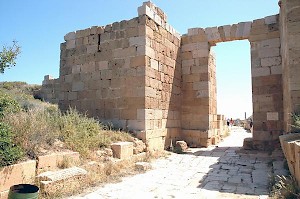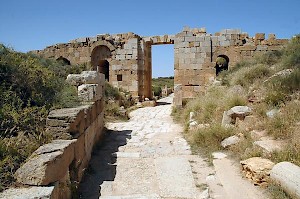Lepcis Magna, Byzantine Gate
Lepcis Magna: Phoenician colony, later part of the Carthaginian empire, the kingdom of Massinissa, and the Roman empire. Its most famous son was the emperor Septimius Severus (r.193-211).

In 455, Lepcis Magna was conquered by the Vandals, a Germanic tribe that had, after a generation of migration, occupied Carthage and embarked upon a pirate's life. The East-Roman armies tried to recover the city in 468, but their operation remained unsuccessful. In 533-534, however, Byzantine (East-Roman) general Belisarius, fighting for the emperor Justinian, reconquered Carthage. Lepcis, Oea, and Sabratha were also reintegrated in the Roman Empire.

Belisarius' courtier Procopius wrote:
Our Emperor built up the circuit-wall of this city from the foundations, not however on as large a scale as it was formerly, but much smaller, in order that the city might not again be weak because of its very size, and liable to capture by the enemy, and also be exposed to the sand.note

The Byzantine Gate was not completely new, however: it replaced an arch over the Cardo that had been built almost five centuries before. Two copies of the original building inscription have been found, and prove that the original arch was an honorific monument, dedicated in 77 or 78 to the emperor Vespasian and his son Titus.
To emperor Caesar Vespasian, Augustus, pontifex maximus,
in his ninth year with tribunicial powers, nineteen times imperator,
father of the fatherland, eight times consul,
and to Titus emperor Caesar Vespasian, son of the Augustus,
priest, imperator, six times consul,
has Gaius Paccius Africanus, priest, consul,
proconsul of Africa, through the agency of
Gnaeus Domitius Ponticus, praetor, deputy
with the rank of propraetor and patron of the city, dedicated [this arch].